Library Top.Preface
Preface
Welcome
Overview
Logic
Proof Assistants
Functional Programming
Program Verification
Type Systems
Further Reading
Practicalities
Chapter Dependencies
System Requirements
Exercises
Downloading the Coq Files
Note for Instructors
Translations
Library Top.Basics
Basics: Functional Programming in Coq
Introduction
Enumerated Types
Days of the Week
Homework Submission Guidelines
Booleans
Function Types
Modules
Numbers
Proof by Simplification
Proof by Rewriting
Proof by Case Analysis
More on Notation (Optional)
Fixpoints and Structural Recursion (Optional)
More Exercises
Library Top.Induction
Induction: Proof by Induction
Proof by Induction
Proofs Within Proofs
Formal vs. Informal Proof
More Exercises
Library Top.Lists
Lists: Working with Structured Data
Pairs of Numbers
Lists of Numbers
Reasoning About Lists
Induction on Lists
Search
List Exercises, Part 1
List Exercises, Part 2
Options
Partial Maps
Library Top.Poly
Poly: Polymorphism and Higher-Order Functions
Polymorphism
Polymorphic Lists
Polymorphic Pairs
Polymorphic Options
Functions as Data
Higher-Order Functions
Filter
Anonymous Functions
Map
Fold
Functions That Construct Functions
Additional Exercises
Library Top.Tactics
Tactics: More Basic Tactics
The apply Tactic
The apply ... with ... Tactic
The inversion Tactic
Using Tactics on Hypotheses
Varying the Induction Hypothesis
Unfolding Definitions
Using destruct on Compound Expressions
Review
Additional Exercises
Library Top.Logic
Logic: Logic in Coq
Logical Connectives
Conjunction
Disjunction
Falsehood and Negation
Truth
Logical Equivalence
Existential Quantification
Programming with Propositions
Applying Theorems to Arguments
Coq vs. Set Theory
Functional Extensionality
Propositions and Booleans
Classical vs. Constructive Logic
Library Top.IndProp
IndProp: Inductively Defined Propositions
Inductively Defined Propositions
Using Evidence in Proofs
Inversion on Evidence
Induction on Evidence
Inductive Relations
Case Study: Regular Expressions
The rememberremember Tactic
Case Study: Improving Reflection
Additional Exercises
Library Top.Maps
Maps: Total and Partial Maps
The Coq Standard Library
Identifiers
Total Maps
Partial maps
Library Top.ProofObjects
ProofObjects: The Curry-Howard Correspondence
Proof Scripts
Quantifiers, Implications, Functions
Programming with Tactics
Logical Connectives as Inductive Types
Conjunction
Disjunction
Existential Quantification
True and False
Equality
Inversion, Again
Library Top.IndPrinciples
IndPrinciples: Induction Principles
Basics
Polymorphism
Induction Hypotheses
More on the induction Tactic
Induction Principles in Prop
Formal vs. Informal Proofs by Induction
Induction Over an Inductively Defined Set
Induction Over an Inductively Defined Proposition
Library Top.Rel
Rel: Properties of Relations
Basic Properties
Reflexive, Transitive Closure
Library Top.Imp
Imp: Simple Imperative Programs
Arithmetic and Boolean Expressions
Syntax
Evaluation
Optimization
Coq Automation
Tacticals
Defining New Tactic Notations
The omega Tactic
A Few More Handy Tactics
Evaluation as a Relation
Inference Rule Notation
Equivalence of the Definitions
Computational vs. Relational Definitions
Expressions With Variables
States
Syntax
Evaluation
Commands
Syntax
More Examples
Evaluating Commands
Evaluation as a Function (Failed Attempt)
Evaluation as a Relation
Determinism of Evaluation
Reasoning About Imp Programs
Additional Exercises
Library Top.ImpParser
ImpParser: Lexing and Parsing in Coq
Internals
Lexical Analysis
Parsing
Examples
Library Top.ImpCEvalFun
ImpCEvalFun: Evaluation Function for Imp
A Broken Evaluator
A Step-Indexed Evaluator
Relational vs. Step-Indexed Evaluation
Determinism of Evaluation Again
Library Top.Extraction
Extraction: Extracting ML from Coq
Basic Extraction
Controlling Extraction of Specific Types
A Complete Example
Discussion
Library Top.Equiv
Equiv: Program Equivalence
Behavioral Equivalence
Definitions
Simple Examples
Properties of Behavioral Equivalence
Behavioral Equivalence Is an Equivalence
Behavioral Equivalence Is a Congruence
Program Transformations
The Constant-Folding Transformation
Soundness of Constant Folding
Proving That Programs Are Not Equivalent
Extended Exercise: Nondeterministic Imp
Additional Exercises
Library Top.Hoare
Hoare: Hoare Logic, Part I
Assertions
Hoare Triples
Proof Rules
Assignment
Consequence
Digression: The eapply Tactic
Skip
Sequencing
Conditionals
Loops
Summary
Additional Exercises
Library Top.Hoare2
Hoare2: Hoare Logic, Part II
Decorated Programs
Example: Swapping Using Addition and Subtraction
Example: Simple Conditionals
Example: Reduce to Zero
Example: Division
Finding Loop Invariants
Example: Slow Subtraction
Exercise: Slow Assignment
Exercise: Slow Addition
Example: Parity
Example: Finding Square Roots
Example: Squaring
Exercise: Factorial
Exercise: Min
Exercise: Power Series
Weakest Preconditions (Optional)
Formal Decorated Programs (Optional)
Syntax
Extracting Verification Conditions
Automation
Examples
Library Top.HoareAsLogic
HoareAsLogic: Hoare Logic as a Logic
Definitions
Properties
Library Top.Smallstep
Smallstep: Small-step Operational Semantics
A Toy Language
Relations
Values
Strong Progress and Normal Forms
Multi-Step Reduction
Examples
Normal Forms Again
Equivalence of Big-Step and Small-Step
Additional Exercises
Small-Step Imp
Concurrent Imp
A Small-Step Stack Machine
Library Top.Auto
Auto: More Automation
The auto Tactic
Searching For Hypotheses
Library Top.Types
Types: Type Systems
Typed Arithmetic Expressions
Syntax
Operational Semantics
Normal Forms and Values
Typing
Progress
Type Preservation
Type Soundness
Aside: the normalizenormalize Tactic
Additional Exercises
Library Top.Stlc
Stlc: The Simply Typed Lambda-Calculus
The Simply Typed Lambda-Calculus
Overview
Syntax
Operational Semantics
Typing
Library Top.StlcProp
StlcProp: Properties of STLC
Canonical Forms
Progress
Preservation
Free Occurrences
Substitution
Main Theorem
Type Soundness
Uniqueness of Types
Additional Exercises
Exercise: STLC with Arithmetic
Library Top.MoreStlc
MoreStlc: More on the Simply Typed Lambda-Calculus
Simple Extensions to STLC
Numbers
Let Bindings
Pairs
Unit
Sums
Lists
General Recursion
Records
Exercise: Formalizing the Extensions
Examples
Properties of Typing
Library Top.Sub
Sub: Subtyping
Concepts
A Motivating Example
Subtyping and Object-Oriented Languages
The Subsumption Rule
The Subtype Relation
Exercises
Formal Definitions
Core Definitions
Subtyping
Typing
Properties
Inversion Lemmas for Subtyping
Canonical Forms
Progress
Inversion Lemmas for Typing
Context Invariance
Substitution
Preservation
Records, via Products and Top
Exercises
Exercise: Adding Products
Library Top.Typechecking
Typechecking: A Typechecker for STLC
Comparing Types
The Typechecker
Properties
Exercises
Library Top.Records
Records: Adding Records to STLC
Adding Records
Formalizing Records
Examples
Properties of Typing
Library Top.References
References: Typing Mutable References
Definitions
Syntax
Pragmatics
Side Effects and Sequencing
References and Aliasing
Shared State
Objects
References to Compound Types
Null References
Garbage Collection
Operational Semantics
Locations
Stores
Reduction
Typing
Store typings
The Typing Relation
Properties
Well-Typed Stores
Extending Store Typings
Preservation, Finally
Substitution Lemma
Assignment Preserves Store Typing
Weakening for Stores
Preservation!
Progress
References and Nontermination
Additional Exercises
Library Top.RecordSub
RecordSub: Subtyping with Records
Core Definitions
Subtyping
Definition
Examples
Properties of Subtyping
Typing
Typing Examples
Properties of Typing
Library Top.Norm
Norm: Normalization of STLC
Language
Normalization
Membership in R_TR_T Is Invariant Under Reduction
Closed Instances of Terms of Type t Belong to R_TR_T
Library Top.LibTactics
LibTactics: A Collection of Handy General-Purpose Tactics
Tools for Programming with Ltac
Identity Continuation
Untyped Arguments for Tactics
Optional Arguments for Tactics
Wildcard Arguments for Tactics
Position Markers
List of Arguments for Tactics
Databases of Lemmas
On-the-Fly Removal of Hypotheses
Numbers as Arguments
Testing Tactics
Check No Evar in Goal
Helper Function for Introducing Evars
Tagging of Hypotheses
More Tagging of Hypotheses
Deconstructing Terms
Action at Occurence and Action Not at Occurence
An Alias for eq
Common Tactics for Simplifying Goals Like intuition
Backward and Forward Chaining
Application
Assertions
Instantiation and Forward-Chaining
Experimental Tactics for Application
Adding Assumptions
Application of Tautologies
Application Modulo Equalities
Absurd Goals
Introduction and Generalization
Introduction
Generalization
Naming
Rewriting
Replace
Change
Renaming
Unfolding
Simplification
Reduction
Substitution
Tactics to Work with Proof Irrelevance
Proving Equalities
Inversion
Basic Inversion
Inversion with Substitution
Injection with Substitution
Inversion and Injection with Substitution –rough implementation
Case Analysis
Induction
Coinduction
Decidable Equality
Equivalence
N-ary Conjunctions and Disjunctions
Tactics to Prove Typeclass Instances
Tactics to Invoke Automation
Definitions for Parsing Compatibility
hinthint to Add Hints Local to a Lemma
jautojauto, a New Automation Tactic
Definitions of Automation Tactics
Parsing for Light Automation
Parsing for Strong Automation
Tactics to Sort Out the Proof Context
Hiding Hypotheses
Sorting Hypotheses
Clearing Hypotheses
Tactics for Development Purposes
Skipping Subgoals
Compatibility with Standard Library
Library Top.UseTactics
UseTactics: Tactic Library for Coq: A Gentle Introduction
Tactics for Introduction and Case Analysis
The Tactic introvintrov
The Tactic invertsinverts
Tactics for N-ary Connectives
The Tactic splitssplits
The Tactic branchbranch
The Tactic
Tactics for Working with Equality
The Tactics asserts_rewriteasserts_rewrite and cuts_rewritecuts_rewrite
The Tactic substssubsts
The Tactic fequalsfequals
The Tactic applys_eqapplys_eq
Some Convenient Shorthands
The Tactic unfoldsunfolds
The Tactics false and tryfalsetryfalse
The Tactic gengen
The Tactics skipskip, skip_rewriteskip_rewrite and skip_goalskip_goal
The Tactic sortsort
Tactics for Advanced Lemma Instantiation
Working of letslets
Working of applysapplys, forwardsforwards and specializesspecializes
Example of Instantiations
Summary
Library Top.UseAuto
UseAuto: Theory and Practice of Automation in Coq Proofs
Basic Features of Proof Search
Strength of Proof Search
Basics
Conjunctions
Disjunctions
Existentials
Negation
Equalities
How Proof Search Works
Search Depth
Backtracking
Adding Hints
Integration of Automation in Tactics
Examples of Use of Automation
Determinism
Preservation for STLC
Progress for STLC
BigStep and SmallStep
Preservation for STLCRef
Progress for STLCRef
Subtyping
Advanced Topics in Proof Search
Stating Lemmas in the Right Way
Unfolding of Definitions During Proof-Search
Automation for Proving Absurd Goals
Automation for Transitivity Lemmas
Decision Procedures
Omega
Ring
Congruence
Summary
Library Top.PE
PE: Partial Evaluation
Generalizing Constant Folding
Partial States
Arithmetic Expressions
Boolean Expressions
Partial Evaluation of Commands, Without Loops
Assignment
Conditional
The Partial Evaluation Relation
Examples
Correctness of Partial Evaluation
Partial Evaluation of Loops
Examples
Correctness
Partial Evaluation of Flowchart Programs
Basic blocks
Flowchart programs
Partial Evaluation of Basic Blocks and Flowchart Programs
Library Top.Postscript
Postscript
Looking Back
Looking Around
Looking Forward
Library Top.Bib
Bib: Bibliography

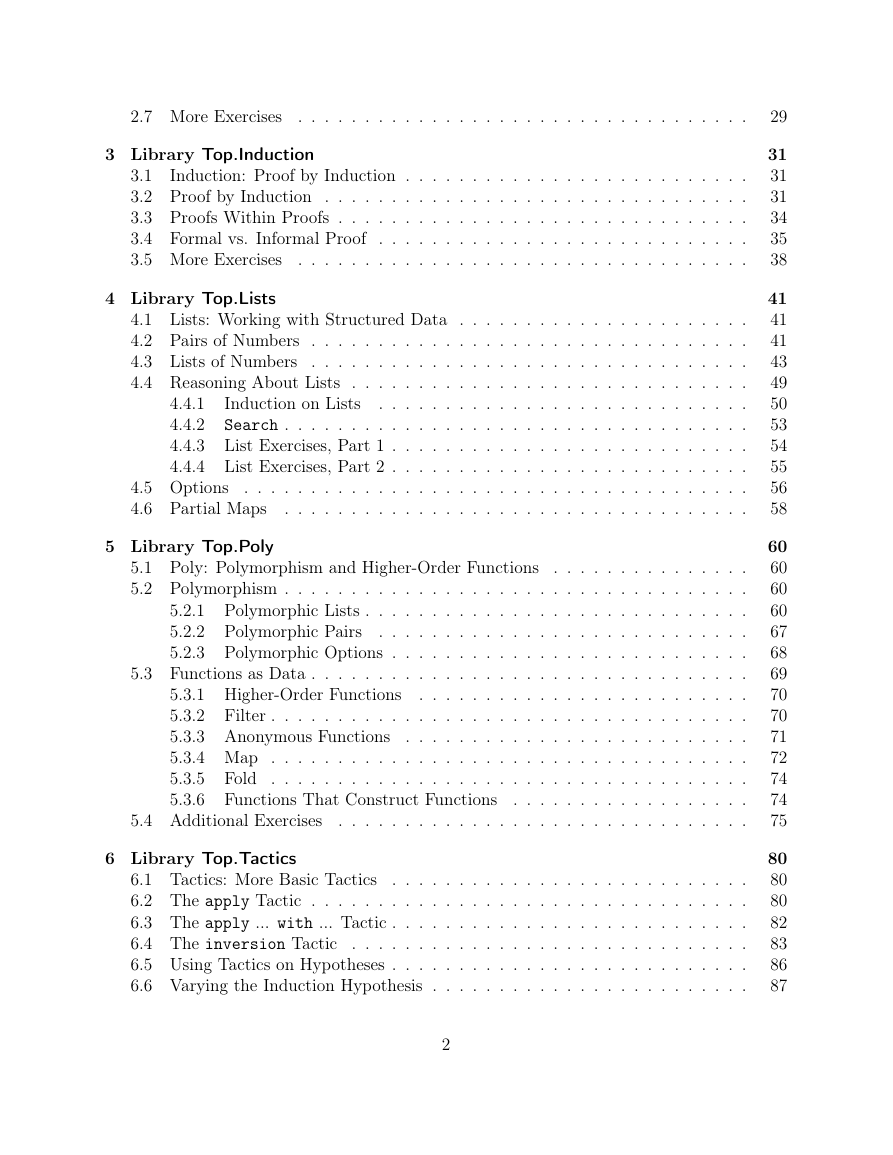

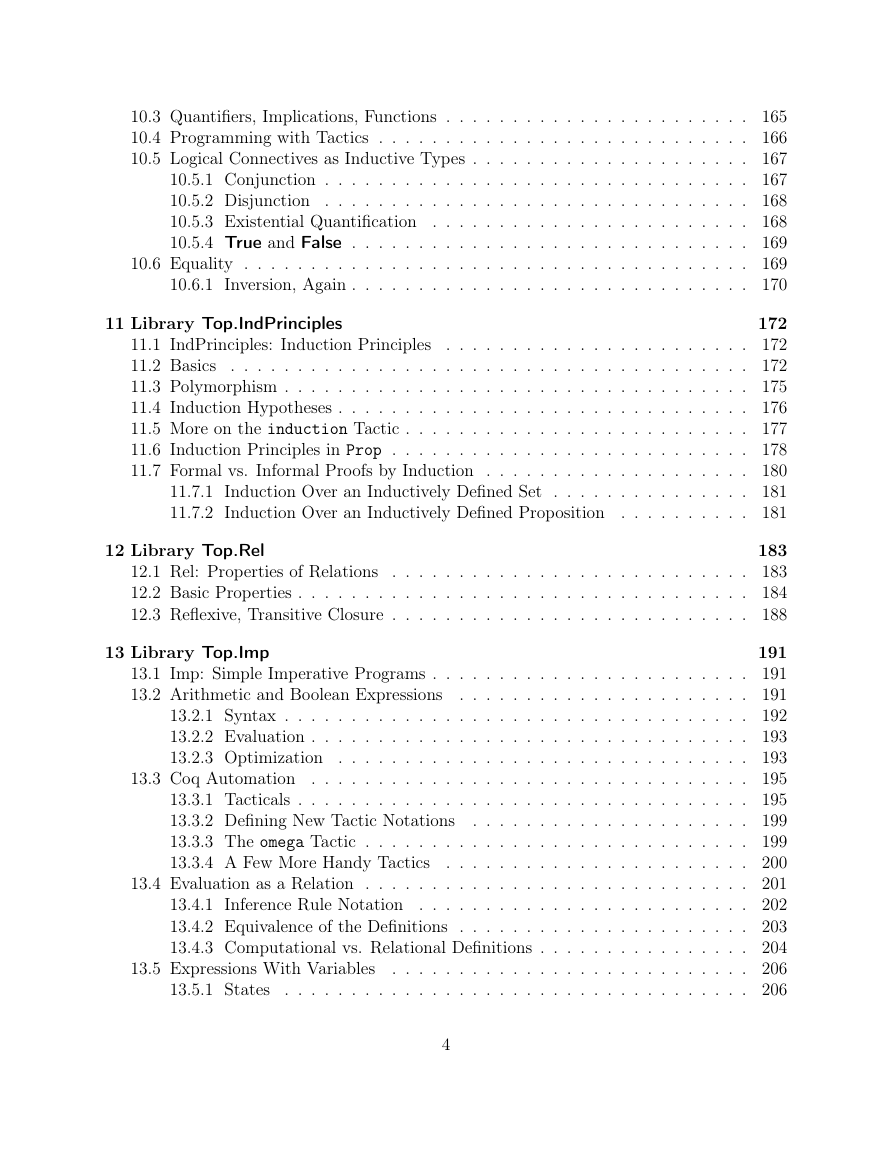

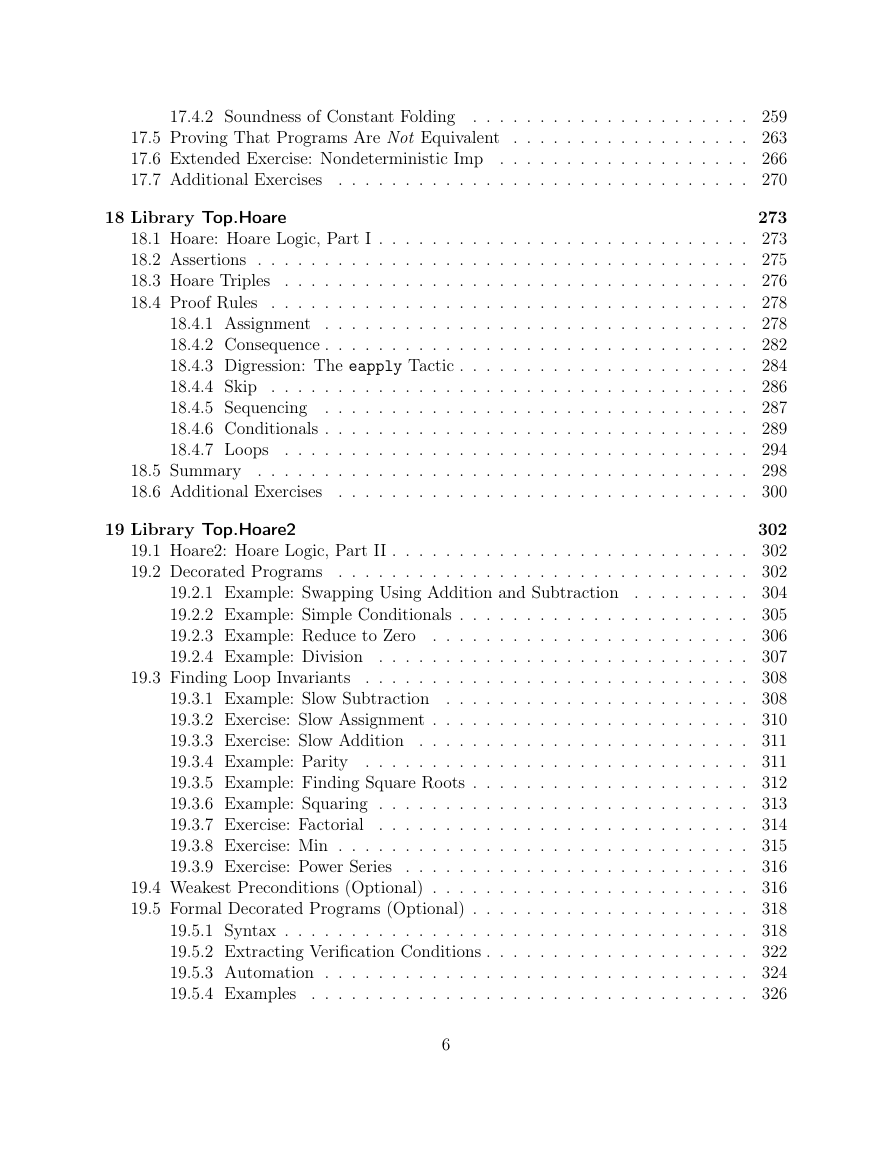
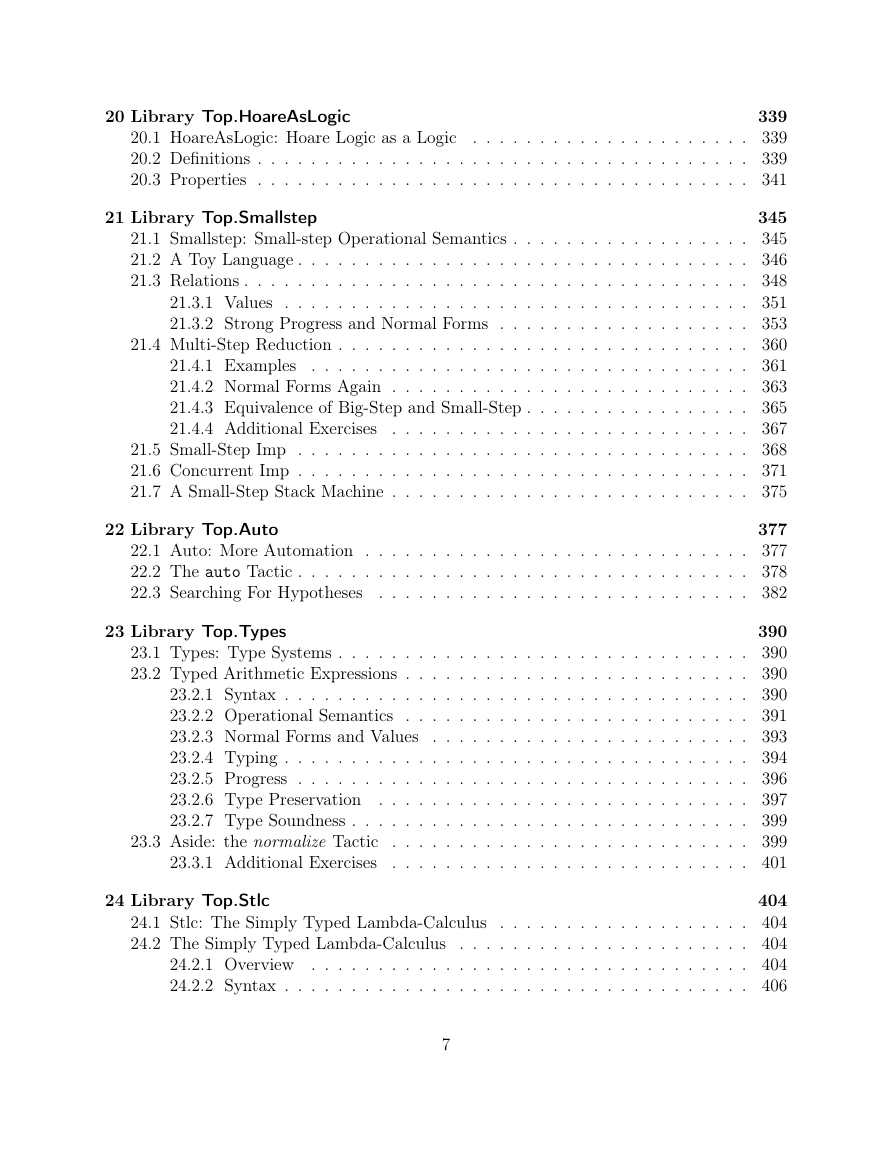
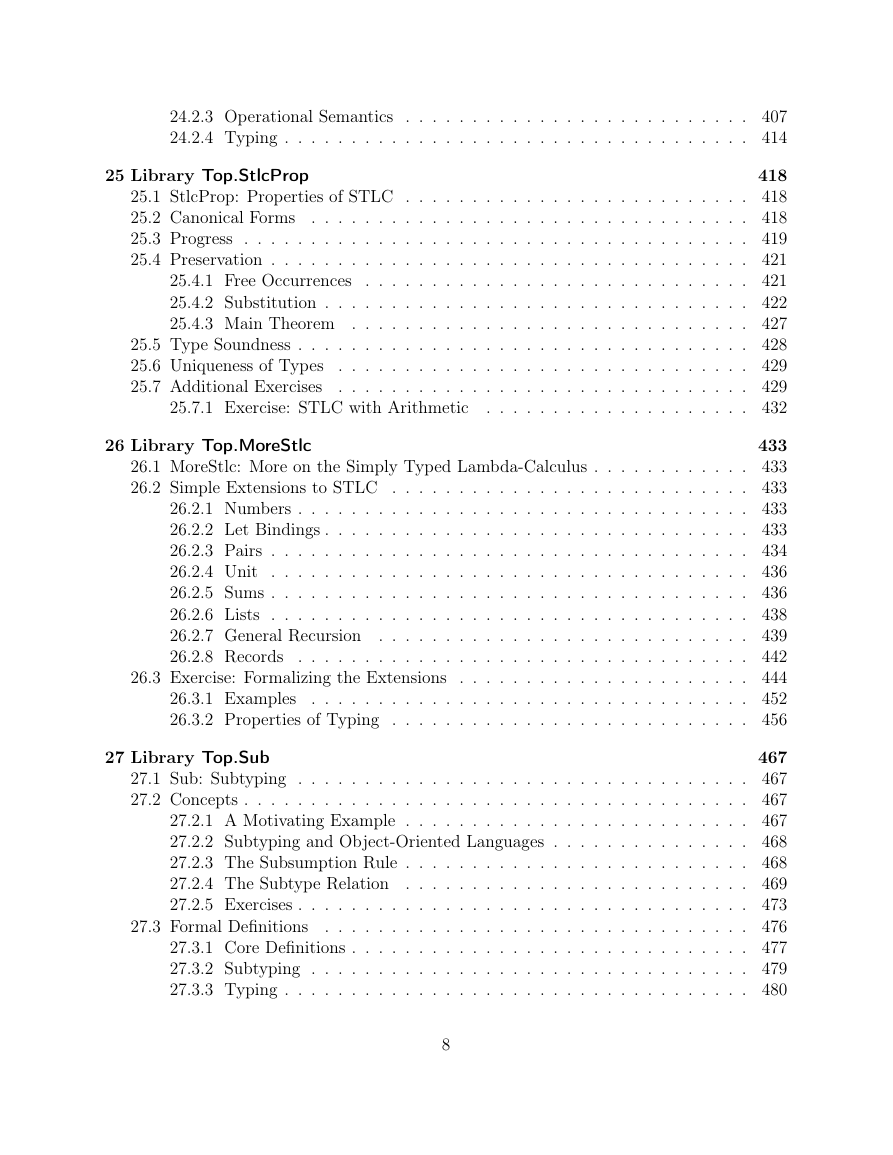








 2023年江西萍乡中考道德与法治真题及答案.doc
2023年江西萍乡中考道德与法治真题及答案.doc 2012年重庆南川中考生物真题及答案.doc
2012年重庆南川中考生物真题及答案.doc 2013年江西师范大学地理学综合及文艺理论基础考研真题.doc
2013年江西师范大学地理学综合及文艺理论基础考研真题.doc 2020年四川甘孜小升初语文真题及答案I卷.doc
2020年四川甘孜小升初语文真题及答案I卷.doc 2020年注册岩土工程师专业基础考试真题及答案.doc
2020年注册岩土工程师专业基础考试真题及答案.doc 2023-2024学年福建省厦门市九年级上学期数学月考试题及答案.doc
2023-2024学年福建省厦门市九年级上学期数学月考试题及答案.doc 2021-2022学年辽宁省沈阳市大东区九年级上学期语文期末试题及答案.doc
2021-2022学年辽宁省沈阳市大东区九年级上学期语文期末试题及答案.doc 2022-2023学年北京东城区初三第一学期物理期末试卷及答案.doc
2022-2023学年北京东城区初三第一学期物理期末试卷及答案.doc 2018上半年江西教师资格初中地理学科知识与教学能力真题及答案.doc
2018上半年江西教师资格初中地理学科知识与教学能力真题及答案.doc 2012年河北国家公务员申论考试真题及答案-省级.doc
2012年河北国家公务员申论考试真题及答案-省级.doc 2020-2021学年江苏省扬州市江都区邵樊片九年级上学期数学第一次质量检测试题及答案.doc
2020-2021学年江苏省扬州市江都区邵樊片九年级上学期数学第一次质量检测试题及答案.doc 2022下半年黑龙江教师资格证中学综合素质真题及答案.doc
2022下半年黑龙江教师资格证中学综合素质真题及答案.doc